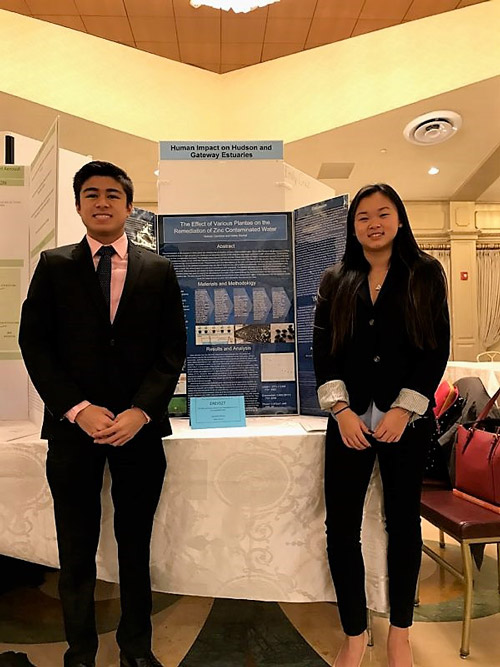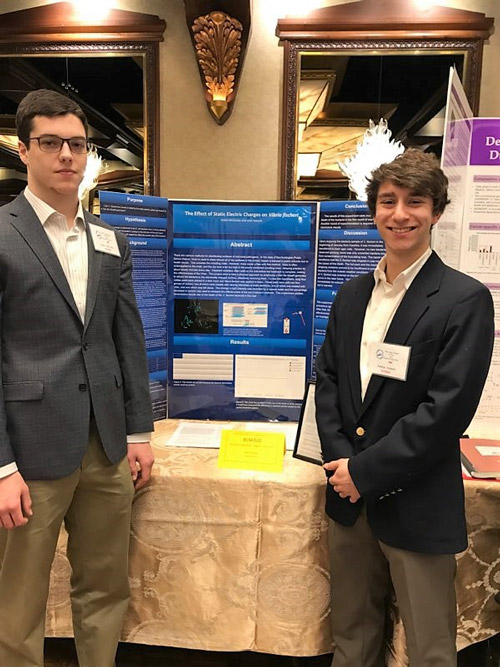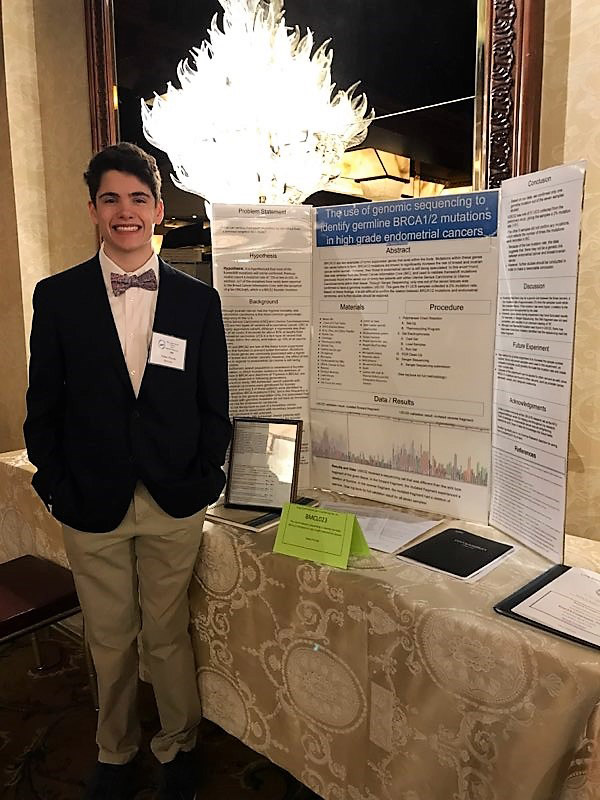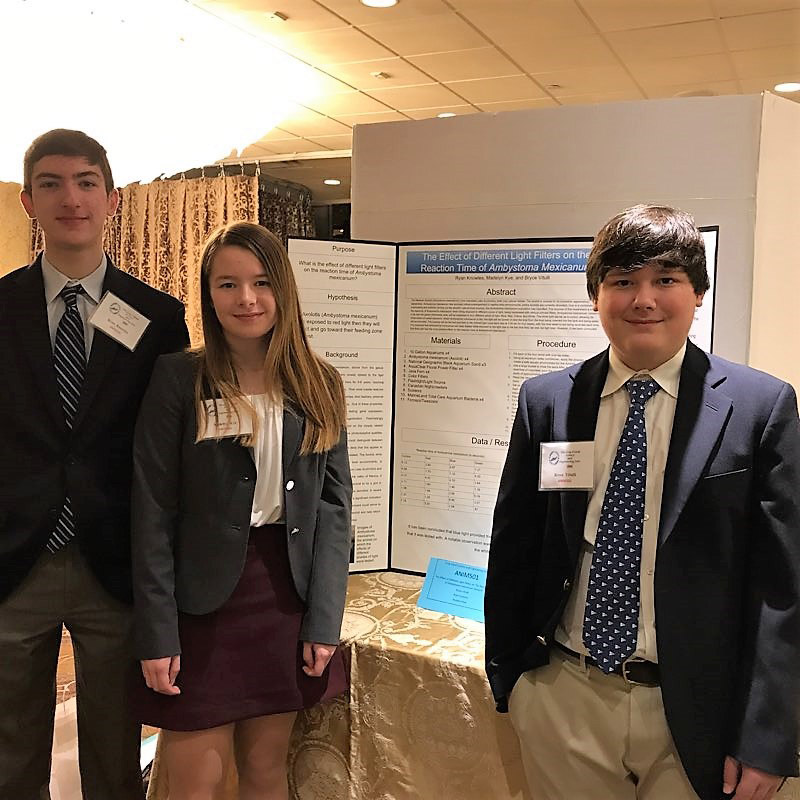A delegation of ten exceptional Huntington High School students participated in this year’s Long Island Science and Engineering Fair at Crest Hollow Country Club, presenting their research projects to judges who were attentive to every small detail.
The Huntington science research program contingent included Nathaniel Gamboa, Haley Mortell, Annabella Matheus, Aidan McCooey, Josh Yanuck, Nolan Piccola, Sebastian Stamatatos, Bryce Vitulli, Madelyn Kye and Ryan Knowles. The group was accompanied by science teacher Lori Kenny and also received mentoring by faculty members Dame Forbes and Debbie Beck.
“They are unique, devoted to their passions and ingenious,” Mrs. Kenny said. “Research is like its own family in the community where we each respect one another’s passions and skills.”
Many of Long Island’s top high school students participated in this year’s competition. “The Charles Duggan Long Island Science and Engineering Fair is a competition for the most advanced high school projects,” according to the LISEF website. “The participants in this fair have a chance to present to professionals in their subject areas from local universities, scientific institutions and professionals in the field.”
Annabella Matheus

Annabella Matheus stands near a presentation of her highly regarded research.
Judges found Ms. Matheus’ project to be especially compelling. “The circadian clock in plants is a complex network of genes that help adjust plants to periodic environmental changes,” states an abstract of the junior’s research. “Both Diurnal and Circadian rhythms are vital to the survival and development of living organisms. Grafting is typically used for agricultural purposes such as in tomatoes. Grafting can be used to obtain healthier crop, by combining disease resistant roots with healthy scion (upper part), in tomatoes. By grafting plants from separate photoperiods it will be easier to study disrupted circadian rhythms effect on tomato plant growth.”
Nathaniel Gamboa and Haley Mortell
Mr. Gamboa and Ms. Mortell teamed up to present the findings of their research. “Phytoremediation is the process in which plants are utilized in the purification of heavy metal polluted water,” according to an abstract of the project. “Zinc is often found in the ground surrounding an industrialized area. In high amounts zinc intake can be extremely harmful to the body and may cause numerous health complications. Complications increase as zinc concentration increases The Mirabilis jalapa (Marvel of Peru) and the Thlaspi rotundifolium (Alpine Pennycress) are both known for their ability to withstand the intake of zinc while the Festuca arundinacea (Tall Fescue) is a common plant. The Marvel of Peru and the Alpine Pennycress have the ability to tolerate high concentrations of zinc. Phytochelatin aid in the detoxification of the cells and repairing them from damage caused by zinc. By placing these plantae into a zinc polluted environment they are able to lower the zinc concentration considerably. However, at high concentrations they lack the ability to lower the concentration to a safe level according to EPA standards.”

Nathaniel Gamboa and Haley Mortell with the findings of their fascinating research.
Mr. Gamboa found the experience of presenting his work to be valuable. “The LI Science & Engineering Fair was an important stepping stone in my research career,” he said. “Being the highest level competition that I have participated in, LISEF offered its challenges. These challenges made it a learning experience. The judges always expect more and for a person to have all the answers. They may ask questions about topics similar to your project, but not identical. LISEF judges have high expectations and only accept a near perfect presentation. I have also learned about the types of projects that are expected at such a high level. It was an unforgettable experience and has better prepared me for future competitions and further research.”
Aidan McCooey and Joshua Yanuck
Messrs. McCooey and Yanuck collaborated on an interesting research project. “There are various methods for disinfecting surfaces of microbial pathogens,” states their abstract. “In the case of the Huntington School District, Virex is used to clean almost all of the surfaces in the school; bleach is banned in public schools due to health issues. This includes the wrestling mats. However, there exists a flaw with this method. Virex is often under-applied to the mats and the dry time is far too high in the poorly ventilated wrestling room, delaying practice by about 20 minutes every day. Impatient wrestlers often walk on the mat before the treatment is complete, voiding the effectiveness of the Virex.”

Aidan McCooey and Josh Yanuck with their research presentation board at Crest Hollow.
The duo’s project involved using a Van Der Graaf generator to attract bacteria to the electrically charged surface and thereby removing them. “To test this hypothesis, 64 rubber pads were placed in a dark room and Vibrio fischeri was applied to them,” according to the project abstract. “These pads were split into four groups of 16; two of which were treated with varying intensities of static electricity, one of which was treated with Virex, and one which was left alone. The change in light intensity was recorded by a lumens meter and the percentage decrease in lumens was used to compare the effectiveness of the two treatment methods.”
Nolan Piccola
Mr. Piccola presented an intricate high-end project. “BRCA1/2 are two examples of tumor suppressor genes that exist within the body,” according to an abstract of his research. “Mutations within these genes can cause tumors to form. BRCA1/2 mutations are known to significantly increase the risk of breast and ovarian cancer within women. However, their threat to endometrial cancer is still being speculated. In this experiment, data was retrieved from the Breast Cancer Information Core and used to validate frameshift mutations previously found within seven out of 92 patients with either Uterine Serous Carcinoma or Uterine Carcinosarcoma within their tissue. Through Sanger Sequencing, only one out of the seven tissues was confirmed to have a germline mutation, USC52. This gave the 51 UCS samples collected a two percent mutation rate. Based on these findings, it is still difficult to confirm the relation between BRCA1/2 mutations and endometrial carcinoma, and further studies should be explored.”
Sebastian Stamatatos
Mr. Stamatatos chose a unique, but quite timely topic for his research. “Property taxes have been increasing for the past two decades, causing many homeowners to either grieve their taxes or move to more economical areas,” according to an abstract of his project. “With the increases in housing prices, homes take longer to sell than they did before the housing market crash during the Great Recession. Homeowners may need to sell their homes in a timely fashion, increasing the need for information about property taxes and their correlation to time on the housing market. An analysis of over-assessment and time on the market was performed and it was hypothesized that an over-assessed home will require more time to be sold.”
Mr. Stamatatos obtained real estate data for his research from Multiple Listing Service. “The homes analyzed were sold from July 1, 2014 to July 1, 2015,” states his abstract. “All were located in Zone 20 (Huntington Township) and were in the price range of 500,000 to 750,000 dollars. The homes were categorized as either over-assessed, under-assessed, or properly assessed based on a comparison between their projected values and actual selling prices. Linear regressions were performed on the data in an attempt to properly linearize the points. Thus, under-assessed homes took a shorter time to sell than homes that were accurately assessed, while no correlation existed between prices of over-assessed homes and their time on the housing market.”
Bryce Vitulli, Madelyn Kye and Ryan Knowles
Bryce Vitulli, Madelyn Kye and Ryan Knowles collaborated on a very interesting research project and presented it at Crest Hollow to eager judges.
“The Mexican Axolotl (Ambystoma mexicanum) once populated Lake Xochilmico, their only natural habitat,” states an abstract of the project. “Revered for its incredible regenerative capabilities, Ambystoma mexicanum has survived critical endangerment in captive bred environments, where they are currently abundant. Due to a combination of overhunting and pollution driving out their natural food sources, the Ambystoma mexicanum population has dwindled. The purpose of this experiment is to test the reactivity of Ambystoma mexicanum when being exposed to different colors of light, being moderated with various colored filters. Ambystoma mexicanum, contained in its own ten gallon freshwater tank, will be subjected to four different colors of light: Blue, Red, Yellow, and White.”
The research team used white light as a control as it allowed for the observation of different reactions. “When Ambystoma mexicanum is fed, the light will be turned on and the time from the food being inserted into the tank and being eaten will be recorded. They will be fed and exposed to the colored light once each day at 7:00 a.m. for four weeks, with the time taken to eat being recorded each time. It is predicted that Ambystoma mexicanum will react fastest while exposed to red light due to the fact that they can see red light best. As the experiment is currently ongoing, a conclusion cannot be provided at this time.”
The ten Huntington science research program students wore business attire to the Crest Hollow and each of the teenagers was articulate and well-versed in all aspects of their project. All of them were anxious to discuss their research goals as well as their procedures and their ultimate findings.
(Huntington High School junior and science research program participant Nathaniel Gamboa contributed to this story.)



